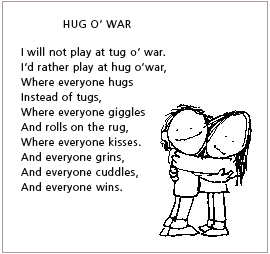10 Criteria for Evaluating Children's Poetry
Sound:
Does the poem sound good? This may sound like a silly question, but if it doesn't it's not going to hold anyone's interest. Here, you also want to ask yourself if the linking and chunking of well chosen, mood generating words sound good enough to make children hungry for more.
Language:
Does the poem use alliteration, assonance, repetition, onomatopoeia? Knowing this will help you guide children into recognizing and utilizing and using these language techniques when talking about or creating their own poetry.
Rhythm:
Is the rhythm of the poem pronounced? In other words, how obvious is the rhythm? Are young children likely to honor the poem with verbal participation, stressing the beat? Or with a motoric response such as a foot tap, a hand clap, a sway, a hop, a jump, or a skip? How does the rhythm reinforce and create the meaning of the poem? Will it help you guide the children through? Is it easy enough for the children to guide themselves through?
Sensory Images:
Are there clear sensory images in the poem? Are these sensory images that create pictures well within the experiences of children? In other words, will they be familiar with what is imagined, or will they need clarification? Do the sensory images reflect children's delight in their particular senses? Due to the length and subject matter of children's poetry, these sensory images hold a fast and compact sensory impact. Knowing what to expect here, will help you guide children through these and help them express their feelings about them, to ensure a positive and full experience with poetry.
Rhyme:
Is the poetry rhymed? Does the poem offer to the young child the predictability of rhyming words? Is he or she being invited to join in by a rhyming refrain, for instance? Do the rhymes sound natural or contrived? Remember, though, that rhyme is not required for a good poem; many good poems do not rhyme but have other strengths, such as imagery and sound.
Humor:
Does the poetry have some humor? Much poetry presented to and lived by children is humorous. Do the images, figurative language, or word play, tickle the fancies of young children?
Emotional Intensity:
How has the poet created the emotional intensity of the poem? Does every word work to heighten the feelings conveyed? Are the words nonsensical, pushed in, embellished or elaborated, minimal? Do the words evoke appropriate feelings and sensations in relation to subject matter?
Quality of Imagination:
What is the quality of imagination in the poem? Does it patronize childhood by looking down on it? Is it too preachy? Does it see childhood in a sentimental or nostalgic way, more likely to appeal to adults than to children? Know what you are offering the children you are presenting this poetry to.
Shel Silverstein
Substance:
Does the poem offer substance? Does the poem offer the child an idea or feeling to chew on or delight in? Does it get them daydreaming or wanting to make their own poem or picture to go with the poem? Will it get them talking? Asking questions? Adding their own bits and thoughts?
Purpose:
What purpose does the poem serve? To amuse? describe an experience in a fresh way? Comment on humanity? draw parallels in our own lives? How well has the poet achieved that purpose? This perhaps the most important set of questions to be asking yourself when it comes to choosing and integrating a poem into a theme, discussion, or activity, as this will be your guide and inspiration for further and related activities.



